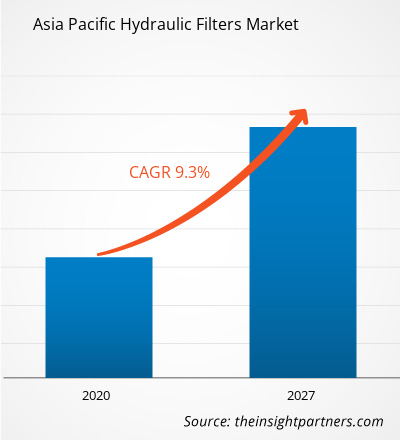The hydraulic filters market in APAC is expected to grow from US$ 646.93 million in 2019 to US$ 1,300.59 million by 2027; it is estimated to grow at a CAGR of 9.3% from 2020 to 2027.
China, India, Japan, Australia and South Korea are major economies in APAC. Cyclone effect technology is combining with hydraulic filters is driving the APAC hydraulic filters market in a positive way. With cyclone-effect, the fluid flow enters filter housing on a tangent to the element. Oil thus envelops the component surface and gets distributed in a downward spiral flowing pattern over the filter media surface. This patent-pending function ensures that heavy contamination particles are carried out outward and away from the filter element, avoiding the pores' premature blockage. These heavier particles will collect on the inside and bottom of the filter tank, increasing the dirt holding ability and extending the time between element replacements by 7-10 percent, depending on the actual fluid flow conditions. Also, the cyclone filter concept can bring significant advantages to hydraulic applications, such as better machine performance, greater reliability, and more effective maintenance. The filter can be cleaned without replacement through the filter bowl detents, which collect larger particles at the bottom of the filter bowl. When replacement is necessary, it can be achieved before the accumulation of particles impact performance. With the filter's installation, hydraulic performance can be safeguarded without the need for a bypass control valve. Thus, the development of the hydraulic filters with cyclone effect technology is one of the major factors anticipated to propel the APAC hydraulic filters market growth during the forecast period.
Further, the ongoing COVID-19 pandemic is having a negative impact over APAC region. The India and China are the two most populated countries as well as manufacturing hubs in the APAC region. The strict lockdown and social isolation in China have negatively impacted the manufacturing as well as production of numerous equipment and machinery for several weeks, resulting in shrinking its country economy. Moreover, the country also isolated its import as well as export of critical raw materials and industrial equipment for numerous industry vertical impacting the supply chain of various end-user industries. Similarly, India also imposed a nationwide lockdown to mitigate the increasing number of COVID-19 cases across the country. Additionally, the closure of several retailers, distributors, and other important distribution channels also has reduced the availability of hydraulic filters or its related component from other region based market players. The governments of various countries in APAC are taking possible steps to reduce the COVID-19 effects by renouncing lockdown, which in turn will impact the revenue generated by the hydraulic filters market.
With the new features and technologies, vendors can attract new customers and expand their footprints in emerging markets. This factor is likely to drive the APAC hydraulic filters market. The asia pacific hydraulic filters market is expected to grow at a good CAGR during the forecast period.APAC Hydraulic Filters Market

- This FREE sample will include data analysis, ranging from market trends to estimates and forecasts.
APAC Hydraulic Filters Market Segmentation
APAC Hydraulic Filters Market – By Product
- Suction Filter
- Pressure Filter
- Return Line Filter
- Off-Line Filter
- Breather Filter
- Others
APAC Hydraulic Filters Market – By End-User
- Manufacturing
- Marine
- Automotive
- Chemical and Petrochemical
- Power Generation
- Agriculture
- Construction
- Metal and Mining
- Others
APAC Hydraulic Filters Market, by Country
- Australia
- China
- India
- Japan
- South Korea
- Rest of APAC
APAC Hydraulic Filters Market - Companies Mentioned
- Bosch Rexroth Corporation
- Donaldson Company, Inc.
- Eaton Corporation Plc.
- Filtration Group Industrial
- HYDAC Technology Ltd.
- MANN+HUMMEL Group
- MP Filtri S.p.A.
- Pall Corporation
- Parker-Hannifin Corporation
- YAMASHIN-FILTER CORP.
Asia Pacific Hydraulic Filters Report Scope
| Report Attribute | Details |
|---|---|
| Market size in 2019 | US$ 646.93 Million |
| Market Size by 2027 | US$ 1,300.59 Million |
| Global CAGR (2020 - 2027) | 9.3% |
| Historical Data | 2017-2018 |
| Forecast period | 2020-2027 |
| Segments Covered |
By Product
|
| Regions and Countries Covered | Asia-Pacific
|
| Market leaders and key company profiles |
- Historical Analysis (2 Years), Base Year, Forecast (7 Years) with CAGR
- PEST and SWOT Analysis
- Market Size Value / Volume - Global, Regional, Country
- Industry and Competitive Landscape
- Excel Dataset



Report Coverage
Revenue forecast, Company Analysis, Industry landscape, Growth factors, and Trends

Segment Covered
Product, and End-user

Regional Scope
North America, Europe, Asia Pacific, Middle East & Africa, South & Central America

Country Scope
Australia, China, Japan, South Korea
Trends and growth analysis reports related to Manufacturing and Construction : READ MORE..
- Bosch Rexroth Corporation
- Donaldson Company, Inc.
- Eaton Corporation Plc.
- Filtration Group Industrial
- HYDAC Technology Ltd.
- MANN+HUMMEL Group
- MP Filtri S.p.A.
- Pall Corporation
- Parker-Hannifin Corporation
- YAMASHIN-FILTER CORP.

 Get Free Sample For
Get Free Sample For